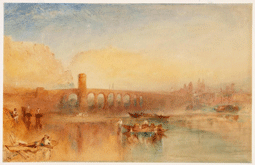Coblenz (Ehrenbreitstein), after J.M.W. Turner
Arthur Palliser Severn (1842-1931). Watercolour on paper, 1880.
WorkSevern made this copy of Turner’s original watercolour for Ruskin. It was intended to record one of Turner’s ‘exemplary’ works.Ruskin commented on this work at the time of its first display at Sheffield. He refers to it as 'a swift but careful study by Mr. Arthur Severn, from the drawing of Coblentz, which Turner made for me in 1842, and which is probably the best example now of his existing style at the period when its fulness of colour rendered all representation of the pictures impossible by engraving' (Works, 30, p. 38). He explains that 'It was lent to the Museum at the Curator's request, and has, I believe, been one of the objects in it found most interesting and instructive; and I should be prepared to recommend its purchase'.Ruskin believed fervently in the value of copies, as educational aids and as means of recording the original; but there were also practical reasons for copying Turner. As he noted to his 'Sheffield friends', 'My own thirty Turners are not infinite, and as long as they are at Oxford, can't be at Sheffield' (Letter 73, Fors Clavigera, 29, p. 15).
ArtistArthur Severn (1842-1931) was the husband of Ruskin's cousin, Joan. Although Ruskin had doubts about his suitability as a match for his dearly loved cousin, Severn possessed an impressive Romantic pedigree: he was the son of Joseph Severn (1793-1879), the painter who nursed John Keats during the final days of his illness. Arthur and Joan Severn lived at Brantwood with Ruskin in his later years. Ruskin on Turner's OriginalIn The Elements of Drawing (1859), Ruskin commented on Turner's original painting: 'The leading or master feature is, of course, the tower on the bridge. It is kept from being too principal by an important group on each side of it; the boats, on the right, and [the mountain] Ehrenbreitstein beyond. Collection of the Guild of St George, Museums Sheffield
The boats are large in mass, and more forcible in colour, but they are broken into small divisions, while the tower is simple, and therefore it still leads. Ehrenbreitstein is noble in its mass, but so reduced by aërial perspective of colour that it cannot contend with the tower, which therefore holds the eye, and becomes the key of the picture.' (Works, 15, p. 167).He continues:'The dual arrangement of these towers would have been too easily seen, were it not for the little one which pretends to make a triad of the last group on the right, but is so faint as hardly to be discernible; it just takes off the attention from the artifice, helped in doing so by the mast at the head of the boat, which, however, has instantly its own duplicate put at the stern. Then there is the large boat near, and its echo beyond it. That echo is divided into two again, and each of those two smaller boats has two figures in it; while two figures are also sitting together on the great rudder that lies half in the water, and half aground. Then, finally, the great mass of Ehrenbreitstein, which appears at first to have no answering form, has almost its facsimile in the bank on which the girl is sitting; this bank is as absolutely essential to the completion of the picture as any object in the whole series. All this is done to deepen the effect of repose.’ (Works, 15, p. 169).
|



















